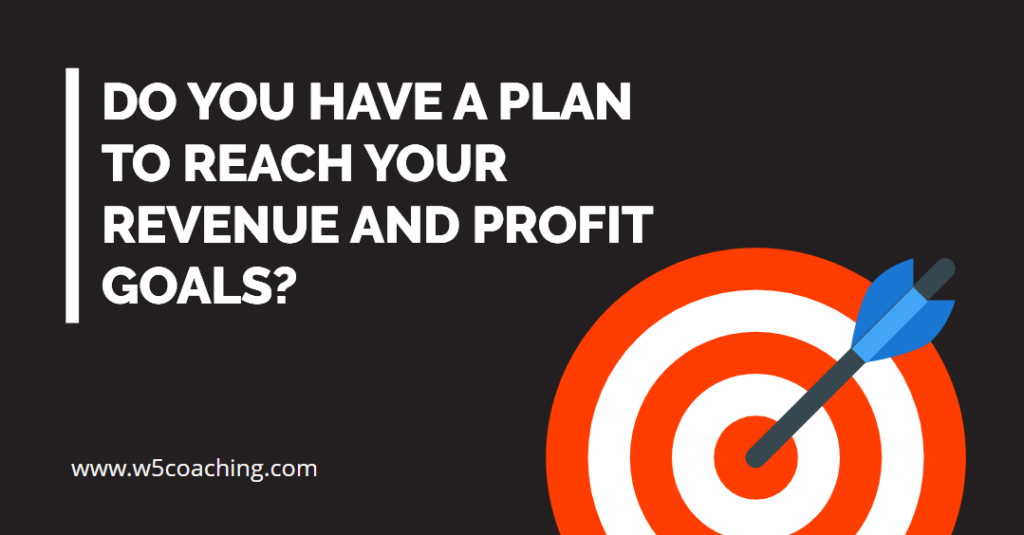Why You Need a Revenue and Profit Plan

Do you know how Kobe Bryant died?
It was a foggy day in Los Angeles. Kobe needed to get from the south part of the city to the north. Driving would have taken hours in L.A. traffic, so he used his private helicopter.
The pilot was flying under VFR (visual flight rules)—in conditions that required IFR (instrument flight rules.)
Which means he was relying on eyesight in heavy fog.
He flew straight into a mountain.
He didn’t even know it was there.
That’s exactly what running your business without a revenue and profit plan feels like: you’re flying blind in the fog, hoping you don’t hit something big and solid.
A Plan Is Your Navigation System
A revenue and profit plan begins with your forecast—your expectation of what you think sales and profits will be.
“I want to add $100,000. I want to grow from $500,000 to $600,000.”
That sounds simple enough—just write down a number—but that one choice triggers a cascade of thinking.
- How many new clients would that take?
- What’s my conversion rate?
- How many leads do I need to generate to support those conversions?
- Is there an opportunity to keep clients longer, or increase the average dollar sale?
- Can I improve my margins?
The moment you create a revenue goal, you’re forced to reverse-engineer it.
And that’s good.
Because now you’re not just hoping things will happen. You’re deciding how to make them happen.
This is what it means to have a navigation plan.
Planning Prevents Bottlenecks
The second reason you need a revenue and profit plan is to make sure you can deliver on the growth you want.
Here’s what I often see: a business owner starts getting busy. Then busier. And suddenly they’re at capacity (or over capacity.)
What happens then? They unconsciously start putting the brakes on growth.
They get slower at following up on leads. They stop chasing new work. Sometimes they even start sabotaging opportunities—because they know deep down they can’t take on any more.
A plan keeps you out of that trap.
If you know you want to grow by 20%, you can see what that means for your delivery.
Maybe you’ll need to hire two more people by year-end. Maybe you’ll need another truck. A plan lets you map out the signposts along the way:
“When I hit this revenue level, I need to start recruiting.”
That way, you don’t run full speed into a brick wall of your own making.
How to Build the Three Plans You Need
A revenue and profit plan doesn’t stand alone. It’s part of 3 distinct plans:
- Your revenue and profit target. What you expect to sell and earn.
- The marketing plan that supports it. Because if you don’t generate enough leads, your revenue goal is just hot air.
- The operational or delivery plan. Because if you can’t deliver on your promises, you’ll stall yourself—or worse, damage your reputation.
All three have to work together.
Here’s how you can put this into practice:
Set aside time to map out your year.
Pick a quiet week. Between Christmas and the New Year works for a lot of business owners, but anytime you can step back will do.
Sketch out different scenarios.
What happens if you stay steady?
What happens if you stretch for 20%, 50%, or double your revenue? Or maybe 10x?
Write down those numbers—even if they feel unrealistic.
Look at it this way: if you shoot for the stars and you hit the moon, it’d still be a pretty good result!
Create two budgets.
- A pessimistic budget: the conservative baseline, the minimum you expect to bring in.
- An optimistic budget: your stretch goal.
Plan your spending to the conservative one but aim your revenue for the stretch version.
Then, take it further:
Look at what each scenario requires.
Would you need to hire? Buy equipment? Raise prices? Target a different kind of customer?
Does anything have to change in your business model to make the bigger number possible?
This isn’t about dreaming.
Planning is about exploring what’s possible and then deciding which version of the future you’re going to pursue.
Most business owners know they should have a revenue and profit plan, but getting it done — and making it realistic — is another story.
It’s easy to either dream too big with no follow-through or stay too safe and never stretch.
That’s where working with a coach can help.
A good coach doesn’t just help you set the numbers — they help you reverse-engineer them into a marketing strategy, operational milestones, and the right team structure. They spot the blind spots before you hit them, keep you accountable when things get busy, and challenge you to see possibilities you might not see on your own.
If you don’t have a clear plan — or if you have one that lives in a drawer and never gets acted on — let’s fix that.
Book a free 15 minute call to talk about coaching and see if it’s a fit for you. We’ll talk through where you are, where you want to go, and what it would take to get you there — with a plan that’s more than just numbers on paper.

Build a Self-Managing Company
How to build a business that runs smoothly, profitably, and (mostly) without you.
Feeling stressed out and overwhelmed with a business that is taking all your time - and not giving you enough in return?
Are you finding it challenging to hire the right team (and get them to do the right things)?
I wrote this little guide for you!
Enter your details below to receive your free copy!
